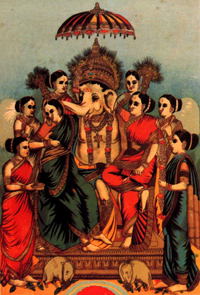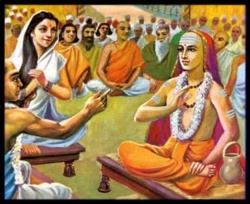Pātimokkha
Pātimokkha: The name given to a set of two hundred and twenty seven rules to be observed by members of the Buddhist Order. The rules are not ethical but mainly economic, regulating the behaviour of the members of the Order towards one another in respect of Clothes, dwellings, furniture, etc., held in common. In four cases out of the two hundred and twenty seven the punishment for infringement of a rule is exclusion from the Order; in all the remaining cases, it is merely suspension for a time.
The rules are arranged in seven sections
- Pārajikā Dhammā
- Sanghādisesā-pātimokkha
- Aniyatā
- Nissaggiyāpācittiyā
- Pācittiyā-pātimokkha
- Patidesanīyā
- Sekkiyā pātimokkha
corresponding very roughly to the degree of weight attached to their observance.
The Pātimokkha is not included in the extant Buddhist Canon. The rules are included, in the Sutta Vibhanga ("Sutta" here meaning "rule"), which contains besides the rules themselves, an old Commentary explaining them and a new Commentary containing further supplementary Information concerning them. The rules are divided into two parts: one for the monks (Bhikkhu Pātimokkha) and the other for the nuns (Bhikkhuknī Pātimokkha). It is a moot point whether the rules originally appeared with the explanatory notes (as in the Vibhanga), the Pātimokkha being subsequently extracted, or whether the Pātimokkha alone was the older portion, the additional matter of the Vibhanga being the work of a subsequent revision. For a discussion of this, see Vin.i. Introd.xvi; Law: Pāli. Lit. 2ff.; Hastings: Encyclopaedia under Pātimokkha.
It is sometimes suggested (Law: op. cit., p.2) that the original number of Pātimokkha rules numbered only about one hundred and fifty. A passage in the Anguttara Nikāya (i.231-232) is quoted in support of this suggestion (sādhikam diyaddhasikkhāpadasatam). According to this theory the seventy five Sekhiyā rules were added later. See Law: op. cit., 19f.; Law's argument, however, that the Pātimokkha rules were among the texts not recited at the First Council, is due to a wrong understanding of the Sumangala Vilāsinī passage (i.17).
The rules were recited at the gatherings of members of the Order (the Uposatha khandha of the Mahā Vagga (Vin.i.101 36) gives details of the procedure at these gatherings) in their respective districts on uposatha days (the fourteenth and fifteenth days of the month). Each section of the rules is recited and, at the end of such recital, the reciter asks the members of the Order who are present if any one of them has infringed any of the rules. Silence implies absence of Guilt. This practice of interrupting the recital seems to have been changed later (see Vin.ii.240 ff.) even though the old formula, asking the members to speak, continued as a part of the recital.
The word pātimokkha is variously explained, the oldest explanation being that the observance of the rules is the face (mukham), the chief (pamukham) of good qualities. The Sanskritised Form of the word being prātimoksa, this led to a change in its significance, the completion of the recital being evidence that all those who have taken part are pure in respect of the specified offences - pātimokkha thus meaning acquittal, deliverance or discharge. But in most contexts the word simply means code - i.e., code of verses for the members of the Order.
For a detailed account of the Pātimokkha rules see Law: Pāli Literature, 49 ff.

